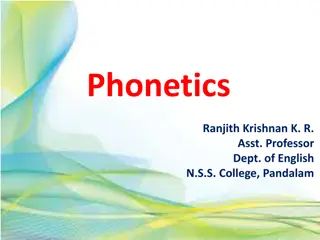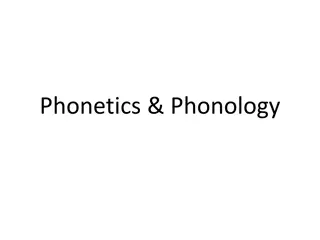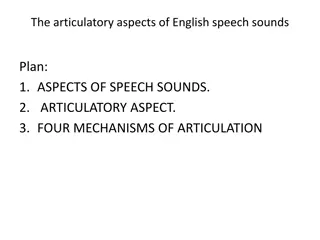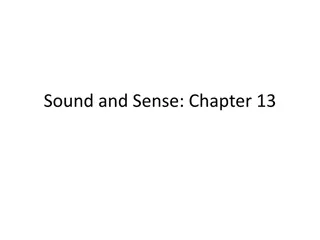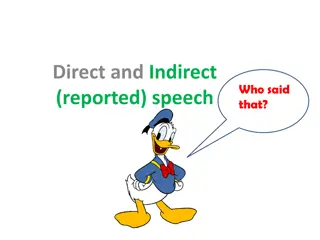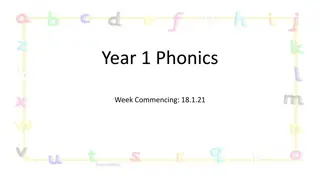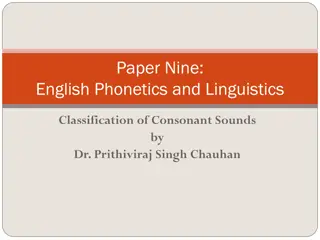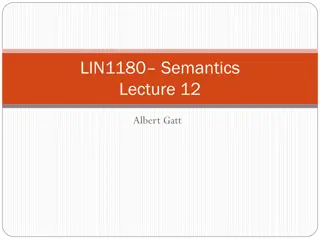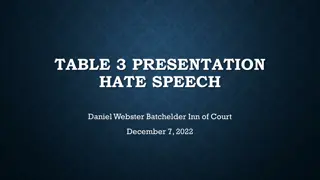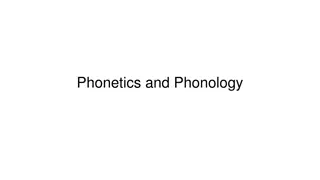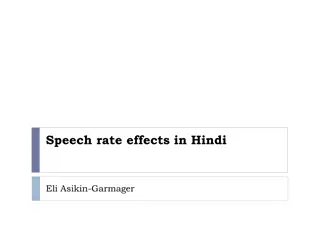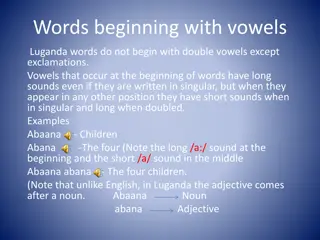Understanding the Functional Aspect of Speech Sounds
The functional aspect of speech sounds delves into the concept of phonemes, phonological and phonetic mistakes in pronunciation, main trends in the phoneme theory, and methods of phonological analysis. It explores the definition of phonemes, the three aspects of phonemes, and the different views on the role of phonemes in language. Through detailed explanations and images, this content provides insights into the intricate world of speech sounds and language distinctions.
Download Presentation

Please find below an Image/Link to download the presentation.
The content on the website is provided AS IS for your information and personal use only. It may not be sold, licensed, or shared on other websites without obtaining consent from the author. Download presentation by click this link. If you encounter any issues during the download, it is possible that the publisher has removed the file from their server.
E N D
Presentation Transcript
The Functional Aspect of Speech Sounds. 1. The Phoneme. 1.1. The definition of the phoneme. 1.2. The phoneme as a unity of three aspects. 2. Phonological and phonetic mistakes in pronunciation. 3. Main Trends in the Phoneme Theory. 4. Methods of PhonologicalAnalysis. 4.1. The aim of phonological analysis. 4.2. Distributional method of phonological analysis. 4.3. Semantically distributional method of phonological analysis. 4.4. Methods of establishing the phonemic status of speech sounds in weak positions. Morphonology. 5. Aspects of speech sounds. Speech sounds as articulatory units and the problem of their classification. 6. Three functions of the phoneme. The system of oppositions. Vowel and consonant adjustments in connected speech: coarticulatory phenomena.
1. The Phoneme. 1.1. The definition of the phoneme. The phoneme is a minimal abstract linguistic unit realized in speech in the form of speech sounds opposable to other phonemes of the same language in order to distinguish the meaning of morphemes and words.
1.2. The phoneme as a unity of three aspects. The phoneme is a dialectal unity of three aspects: 1) material, real and objective, 2) abstractional and generalized, 3) functional.
Phonological pronunciation. 2. and phonetic mistakes in If an allophone is replaced by an allophone of a different phoneme the mistake is called phonological, because it affects the meaning of words: bit: [bi:t] vs. [b t]. If an allophone of the phoneme is replaced by another allophone of the same phoneme the mistake is called phonetic, because the meaning of the word does not change: [ph t] / [p t].
3. Main Trends in the Phoneme Theory. I. The psychological view regards the phoneme as an ideal mental image that the speaker bears in mind when pronouncing allophonic variants. The Olexandrovych Edward Sapir, Alf Sommerfelt, Mark Tatham. This conception is rejected by Leonard Bloomfield and Daniel Jones on the basis that it s impossible to establish ideal sounds which don t exist in reality. founders of the phoneme theory Courtenay, Ivan Baudauin de
II. The functional view regards the phoneme as the minimal sound unit by which meanings can be differentiated. For example, the words ladder and latter are said to differ only in one feature of the third sound: lenis or fortis characteristics [ d t]. This view is shared Sergeyevich Trubetzkoy, Roman Osipovich Jacobson, Leonard Bloomfield, and others. by Nikolai
III. The abstract view regards phonemes as units which are independent of speech sounds. This approach was originated by Ferdinand de Saussure and advocated Hjelmslev and Hans Jorgen Uldall . by Louis NB: The second and third views are rejected as purely idealistic conceptions which do not take into consideration the real human speech.
IV. The physical view regards the phoneme as a family of related sounds that have phonetic similarity and do not occur in the same phonetic context. This conception was proposed by Daniel Jones and shared by American linguists Bernard Bloch and George Trager. The lack of this approach is that it studies the phoneme from the point of view of its articulatory characteristics only without any regard to its functional aspects.
V. According to the materialistic view, originated by Lev Volodymyrovych Shcherba, the phoneme is defined as a real, independent distinctive unit which has its material manifestation in the form of allophones. This view is widely recognized in modern phonology, its followers are Leo Zinder, Margaret Matusevich, Maria Sokolova and others.
4. Methods of Phonological Analysis. 4.1. The aim of phonological analysis. The aim of phonological (phonemic) analysis is to determine phonemic (functional) and non- phonemic (articulatory) differences of speech sounds and to identify the inventory of language phonemes.
The phonological analysis can be fulfilled within two steps: The first step is to identify the segments continuum and record them graphically means of transcription. The second step is to arrange the sounds into functionally groups in order to find contrastive sounds and allophones of the same sounds. minimal speech of similar by phoneme allophonic
4.2. Distributional method of phonological analysis. Phonemes of any language are discovered by rigid classification of all the sounds pronounced by native speakers according to the following laws of phonemic and allophonic distribution: allophones phonemes occur in the same phonetic context and their distribution is contrastive; of different allophones of the same phoneme(s) never occur in the same phonetic context, their distribution is complementary and the choice depends on phonetic environment.
4.3. Semantically distributional method of phonological analysis. The semantic method is based on the functional rule that phonemes can distinguish words and morphemes when opposed to one another. It consists in the systemic substitution of one sound for another in the same phonetic context in order to find cases in which such a replacement leads to the change of meaning. This procedure is called the commutation test and it helps to establish minimal oppositional pairs of words and word-forms presenting different meaning.
4.4. Methods of establishing the phonemic status of speech sounds in weak positions. Morphonology. According to Sokolova M., morphonology is concerned with the way in which sounds can alternate as different realization of one and the same morpheme. To establish the phonemic status of speech sounds we should consider the cases when the sounds are in the weak position, or the position of neutralization: 1) wind+y", "dust+y", "sunn+y have two morphemes and the function of the morpheme "-y" is to convert a noun into an adjective. This morpheme has a grammatical meaning. 2) malice | m l s| - malicious |m l s|; active | kt v| - activity |ak t v ti| exemplify a sound alternation in one and the same morpheme of two different parts of speech (nouns and adjectives).
5. Aspects of speech sounds. Speech sounds as articulatory units and the problem of their classification. 1) The articulatory/sound production aspect: from the articulatory point of view every speech sound is a complex of definite coordinated and differentiated movements and positions of speech organs. 2) The acoustic aspect: every speech sound is a complex of acoustic effects and has its physical properties - it is a physical phenomenon, a kind of moving matter and energy. The physical (acoustic) properties of speech sounds consist of: frequency, spectrum, intensity, duration. 3) The auditory/sound-perception aspect involves the mechanism of hearing. It is a kind of psychological mechanism which (1) reacts to the physical properties of speech sounds, (2) selecting from a great amount of information only the one which is linguistically relevant. 4) The functional/linguistic/social aspect is called so because of the role the sounds of language play in its functioning as medium of human communication
Differences between VOWELS (V) and CONSONANTS (C) 1) The most substantial articulatory difference between vowels and consonants is that in the articulation of V the air passes freely through the mouth cavity, while in making C an obstruction is formed in the mouth cavity and the airflow exhaled from the lungs meets a narrowing or a complete obstruction formed by the speech organs. 2. From the acoustic point of view, vowels are called the sounds of voice, they have high acoustic energy, and consonants are the sounds of noise which have low acoustic energy. 3. Functional differences between Vs and Cs are defined by their role in syllable formation: Vs are syllable forming elements, Cs are units which function at the margins of syllables, either singly or in clusters.
Heinz Giegerich [1992], Martha Carswell Pennington [1996] use a set of basic binary (two-way) distinctions to classify the sounds of a language in terms of: 1) phonation (the behavior of the vocal cords in the glottis during the production of the sound); 2) oro-nasal process (the modification of that flow of air in the vocal track, from the glottis to the lips and nose); 3) manner of articulation (the configuration and interaction of the articulators (speech organs such as the tongue, lips, and palate) when making a speech sound).
1) Phonation 2) Oro-nasal process 3) Manner of articulation Sonorants Obstruents (noise consonants) Oral Nasal Stops (plosives) Continuants: consonant types - fricatives, - affricates, - approximants: [r, w, j] are central approximants; [1] is called a lateral approximant; [h] is a glottal approximant; OR semi-consonants [1, r]; semi-vowels [w, j]. and vowels three
Articulatory consonants into certain groups according to distinctive changes in classification organizes English the degree of noise, the manner of articulation, the place of articulation, the presence of voice , the position of the soft palate.
A minimum vowel system of any language [a] [i] [u]
The most common vowel system with 5 vowels [a] [e] [o] [i] [u]
The British linguist D. Jones tried to establish a broader classification of vowels for all languages. He devised the system of eight Cardinal Vowels on the physiological basis with the help of X-ray photography of the tongue positions. This system is recognized by most foreign linguists and serves the basis of the International PhoneticAlphabet (IPA). Articulatory classification of distinctive changes in the stability of articulation, the tongue position, the lip position, the vowel length, the vowel tenseness, the character of the vowel end. English vowels describes
6. Three functions of the phoneme. The system of oppositions. Vowel and consonant adjustments in connected speech: coarticulatory phenomena. The phoneme is viewed as a functional, material and abstract unit, which performs three functions: distinctive, constitutive, recognitive.
1. The phoneme as a functional unit performs the distinctive function. It distinguishes different sounds in a contrastive sense and serves as the smallest language unit that discriminates between larger language units. Thus, the opposition of phonemes in the same phonetic environment differentiates the meaning of morphemes, words and even sentences. E.g., sleeper sleepy; bath path, light like; He was heard badly He was hurt badly.
2. The phoneme is a material, real and objective unit that performs the constitutive function. The phoneme is realized in speech in the form of its variants or allophones, which do not make meaningful distinctions and serve to constitute the material form of morphemes. E.g., cap [kh ph] / [kh p] the loss of plosion in the final phoneme [p] doesn t bring any change of meaning.
3. The phoneme is also an abstract and generalized unit, which performs the recognitive function. The phoneme serves to distinguish and understand the meaning, because the use of the right allophone in the certain phonetic context understand the message and thus facilitates normal recognition. E.g., take it tape it the difference in two phrases is understood by two different phonemes. helps the listener to
Trubetzkoy has worked out the classification of Nikolai Sergeyevich phonological oppositions which is based on the number of distinctive features. 1. A single phonological opposition is established on the basis of a single difference in the articulation of two speech sounds: pen ben - common features (occlusive, labial), differentiating feature (fortis vs. lenis). 2. A double phonological opposition marks two differences in the articulation and presents a sum of two single oppositions: pen den - common feature (occlusive), differentiating features (labial vs. lingual, voiceless-fortis vs. voiced-lenis). 3. A triple phonological opposition has three articulatory differences, presenting a sum of three single oppositions: differentiating features in pen then (occlusive vs. constrictive, labial vs. dental, voiceless-fortis vs. voiced-lenis).
Sound adjustments in connected speech can be summarized as follows: Types of adjustments Kinds of adjustments 1. Assimilations = modifications of a C under the influence of a neighboring C, for ex.: ten mice [tem mais] 1 Adjustments related to C-C linking 1. Liaison = connecting of the final sound of one word or syllable to the initial sound of the next, for ex.: a phrase such us far away, far out is usually pronounced with [fa:r]. 2 Adjustments related to V-V, C-V, V-C linking 2. Accommodation (adaptation) = modifications of C under the influence of the adjacent V or vice versa: e.g. two = labialized [t] under the influence of the rounded [u]; let = more open [e] after [l]. 3. Glottal stop / hard attack, symbolized [?], is a plosive made at the glottis by the vocal folds. For ex.: atmospheric [, tm s'ferik] [, ?m s-].
1. Elisions (elipsis or omission) = deletion of a sound in rapid or careless speech. For ex.: a phrase, such as next thing, next question, is often pronounced with elision of the [t] in [neks]. 3 Adjustments related to sound deletion / insertion 2. Epenthesis = inserting of a V or C segment within an existing string of segments. For ex.: in RP, however, as in other non-rhotic accents (some of New England accents and in New York City) speakers tend to add an intrusive [r] to V+V sequence even when there is no [r] in the spelling of the preceding word, e.g. comma ['k m r], ['ka:m r]. In isolation, the RP form is ['k m ]. But in a phrase such put a comma in, it is often pronounced ['k m r]. In GenAm it is always ['ka:m r], whatever the environment. 3. Smoothing = a diphthong optionally loses its second element before another vowel, or it is monophthongized: E.g.: fire ['fai -'fa - 'fa:].
Compression when two syllables, usually both weak, optionally become one. Applies only to [i], [u], syllabic consonants: [i] becomes like [j], e.g. lenient ['li:ni nt] - ['li:nj nt], etc. 4 Adjustments on the syllable level Weakforms are alternate forms of words so reduced in their articulation that they consist of a different set of phonemes. Weakforms differ from containing a weak vowel reduction or by elision of one or more of its phonemes, e.g. can [k n], [kn] 5 Weakening strongforms resultant by from



